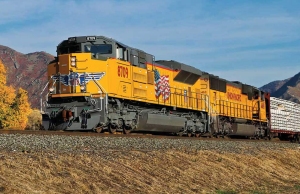What Is Precision Scheduled Railroading?
Published by Union Pacific
 October 2019 - Do you keep hearing about Precision Scheduled Railroading but wonder what that really means? The short answer is it’s a new service model many North American Class I railroads have adopted or are adopting in an effort to streamline operations. Precision Scheduled Railroading (PSR) looks a little different from railroad to railroad, but at its core it’s intended to benefit customers by providing consistent, reliable, predictable service. How are those goals achieved? Let’s take a closer look and chase down the answers to some of the most commonly asked questions. October 2019 - Do you keep hearing about Precision Scheduled Railroading but wonder what that really means? The short answer is it’s a new service model many North American Class I railroads have adopted or are adopting in an effort to streamline operations. Precision Scheduled Railroading (PSR) looks a little different from railroad to railroad, but at its core it’s intended to benefit customers by providing consistent, reliable, predictable service. How are those goals achieved? Let’s take a closer look and chase down the answers to some of the most commonly asked questions.
How Did Freight Rail Service Work before PSR?
In the past, the North American rail service model focused on moving long trains in order to maximize capacity and yield the greatest efficiency. While railroads would operate both unit trains (a train moving a single commodity) and manifest service (trains carrying a variety of commodities), unit trains were the preferred method to move a train, since faster train speed (also known as “velocity”) was the ultimate goal.
However, operating this way didn’t always yield the best outcome for railroads or customers. Since railroads aimed to build long trains that would move faster, if a train didn’t meet a specific length requirement, it could be canceled (or “annulled,” as they say in the rail industry), leaving customers without service for the day. This “train focus” meant customer cars could sit for long periods of time before being picked up and delivered.
How Does Freight Rail Service Work with PSR?
Where railroads previously focused on moving trains, PSR shifts that focus to moving cars. So, instead of waiting for a long train to be built, trains are always moving and cars are picked up on schedule, regardless of train length. Velocity and train length are still important to railroads, but now, the focus on moving cars takes precedence.
What railroads found is that the focus on moving trains was actually slowing down the network overall and causing cars to sit for long periods of time in yards (a measurement railroaders call “dwell”) — and that’s inefficient for both railroads and their customers. And when overall rail network velocity slows, equipment does not cycle (return to its owner) as fast, meaning more unproductive cars are on the network. The result? Cars aren’t always available when needed, the network is congested and service isn’t as dependable.
In addition to promoting network fluidity and more reliable service, this shift in focus also yields another important advantage: As trains continually move through the network, it becomes more balanced — meaning the right resources, like crews, cars and locomotives, are in place when they are needed. For railroads, that means more effective use of resources. For customers, it means service is more reliable And they may not have to purchase as many rail cars for their private fleet. As rail cars go out then come back faster, greater rail car availability means fewer cars are needed overall.
What Does this Mean for Rail Customers?
Remember that the goal of PSR is to keep cars moving, reduce dwell and operate a balanced network, which in turn yields more reliable service. With that in mind, here’s how it works:
- Rail cars don’t have to wait for trains to reach a certain length to be moved. So, when a car is scheduled for pick up, it will be picked up as scheduled, not canceled at the last minute.
- When the car arrives at the serving yard (the yard where it lands prior to final delivery or departure) it will be picked up as soon as local service allows.
- If the customer can’t receive the car on that day, they may be assessed a daily charge.
- Except where proven to be the most efficient method, most cars will travel by manifest service, not unit train.
The result is reduced car dwell, which means better utilization of cars — and ultimately, more reliable and predictable service.
Rail Talk Is Confusing. What’s a Comparable Example?
To clear things up, let’s compare railroading to air travel.
 Shifting from a train focus to a car focus: Imagine you’re going on a much-needed vacation to the Bahamas. You get to the airport and are so excited that you can already smell the salty ocean air. But then, while waiting at the gate, an announcement comes on saying your flight has been canceled because there weren’t enough passengers booked on the flight. What?! You’re told you’ll have to wait until tomorrow to catch the next flight when more passengers will be on board. So now you’ve wasted a vacation day from work and have one less day to spend on the beach. That’s frustrating, and it’s a waste of your time and money. Shifting from a train focus to a car focus: Imagine you’re going on a much-needed vacation to the Bahamas. You get to the airport and are so excited that you can already smell the salty ocean air. But then, while waiting at the gate, an announcement comes on saying your flight has been canceled because there weren’t enough passengers booked on the flight. What?! You’re told you’ll have to wait until tomorrow to catch the next flight when more passengers will be on board. So now you’ve wasted a vacation day from work and have one less day to spend on the beach. That’s frustrating, and it’s a waste of your time and money.
While airlines don’t delay takeoff just because a flight hasn’t reached maximum capacity, in the old model, trains did. In this example, keeping people from boarding until capacity is reached is a lot like holding cars until a train of a certain length is built. And, just like no one likes their vacation to be delayed, no one likes supply chain disruptions, either.
With PSR, this doesn’t happen. Instead of sitting in the yard waiting for a long train to be built, the car will simply be added to the next scheduled train. This approach eliminates variability, allows for more precise supply chain management, and results in more consistent transit times.
Balancing the network: Now, imagine you’re back at the airport in the Bahamas to catch your flight home. Once again, you can’t board — but this time, there are no planes or crews available because they’ve all flown out of the Bahamas, but haven’t returned yet.
That’s what happens in an unbalanced network — the resources needed to move your freight aren’t available. The PSR model works to balance the rail network and ensure the right resources are in place to move your products on schedule — in other words, making sure that crew and that plane are there to get you home.
What Are the Benefits to Shippers and Receivers?
Railroads like PSR because it increases asset utilization, improves service reliability and is a more efficient way of operating. But railroads aren’t the only ones who benefit.
Customers can expect more reliable, consistent and faster rail service that will in turn help them strengthen their overall supply chain and reduce costs.
More specifically, if you’re a customer of a railroad that leverages PSR, you can:
- Expect a more accurate transportation plan and consistent rail service
- Better meet your customers’ expectations and reduce supply chain variability thanks to more reliable service
- Improve the utilization of your rail cars and other assets
- See reduced transit times
- Reduce the costs associated with supply chain disruptions
Although rail customers may have to adjust to some changes, the shift to PSR comes with many opportunities for improved freight shipping and total supply chain efficiency.
SOURCE: Union Pacific |